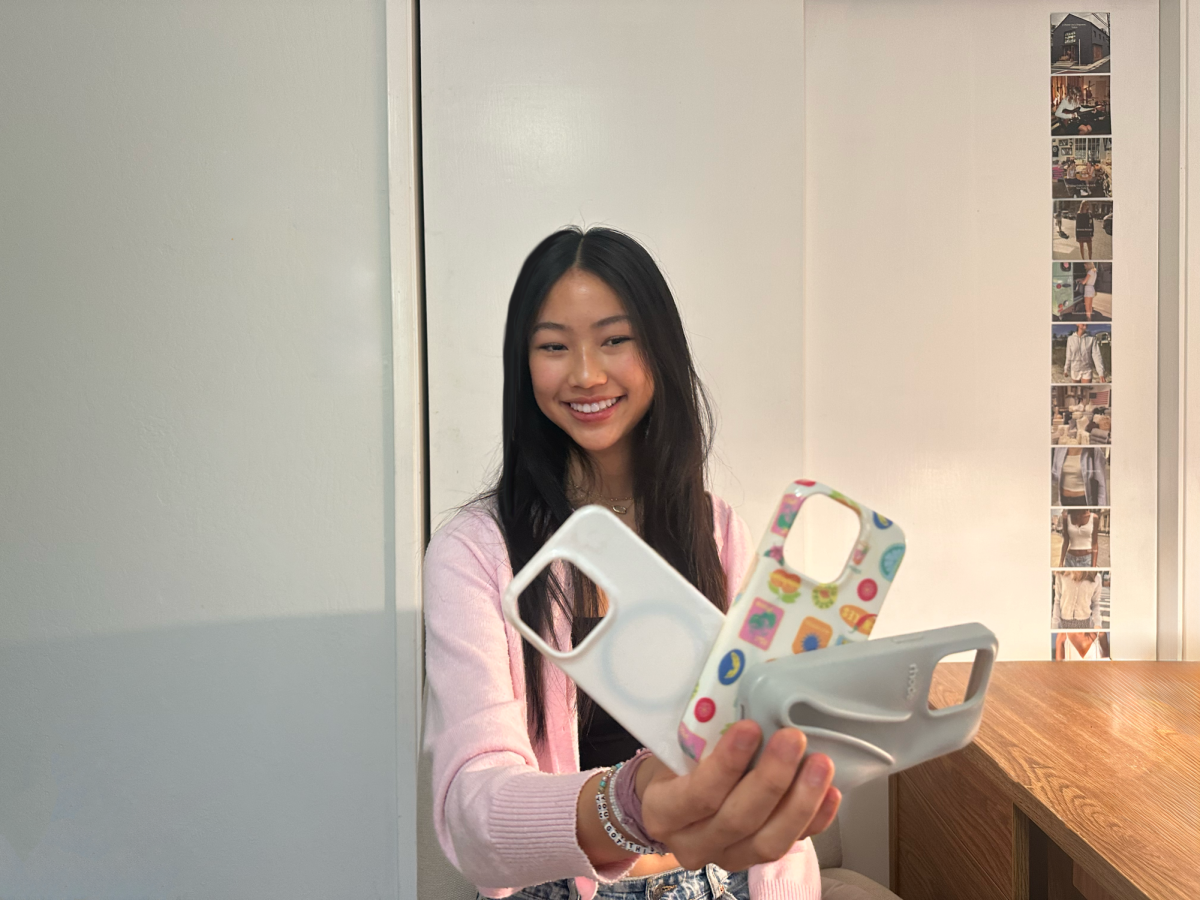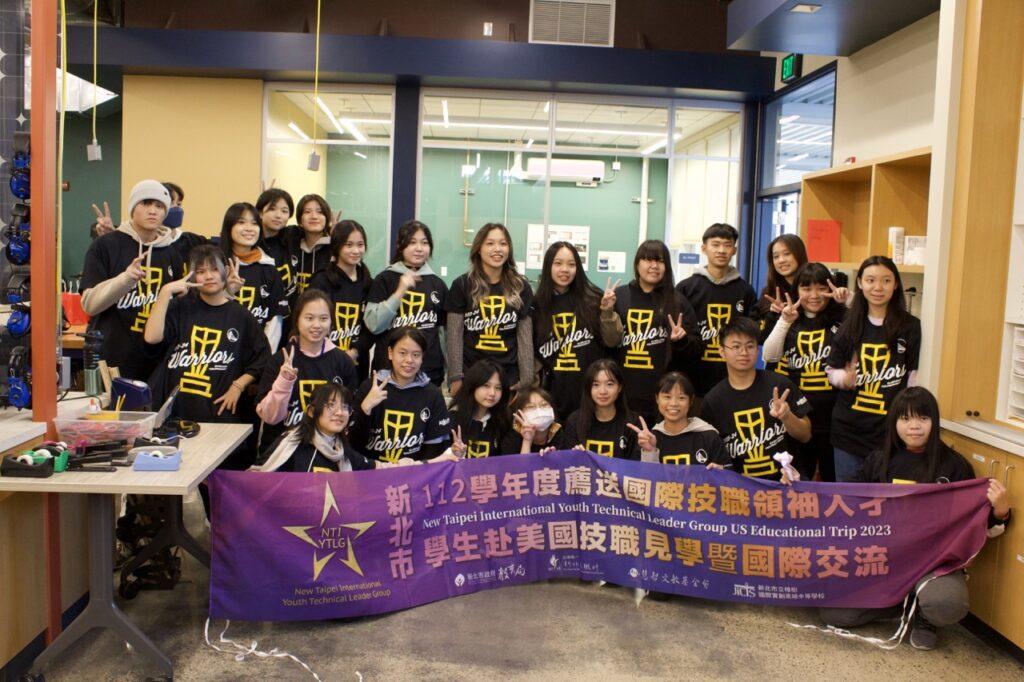Thirty-one students and their chaperones, all wearing matching gray puffer jackets, filed out of a bus on the chilly Thursday morning of Dec. 7. They made their way to the cafeteria, where they were greeted by a crowd of juniors and seniors who volunteered to be host students, as well as several administrative staff members.
These visitors, a group of Taiwanese senior high school third-years (the equivalent of 12th graders in the United States) from various educational institutions in New Taipei City, were on a 2-week tour of the San Francisco Bay Area to learn about its educational and job opportunities and culture. SHS was one of the stops.
Principal Greg Louie gave brief welcoming remarks to the visitors, and each guest was introduced to their host student and accompanied them to their classes.
During tutorial on Dec. 7, the guests congregated in the Student Center to participate in a school-wide scavenger hunt. At lunch, the guests and their host students returned to the Student Center to enjoy a stereotypically American lunch of pepperoni and cheese pizzas catered by the school.
On the second and final day of the visit, Dec. 8, the guests and host students once again met in the cafeteria before going to their classes. During tutorial, the guests engraved small artworks in the art room under the guidance of Ceramics teacher Nikki Rodriguez and experienced American public school cafeteria food during lunchtime.
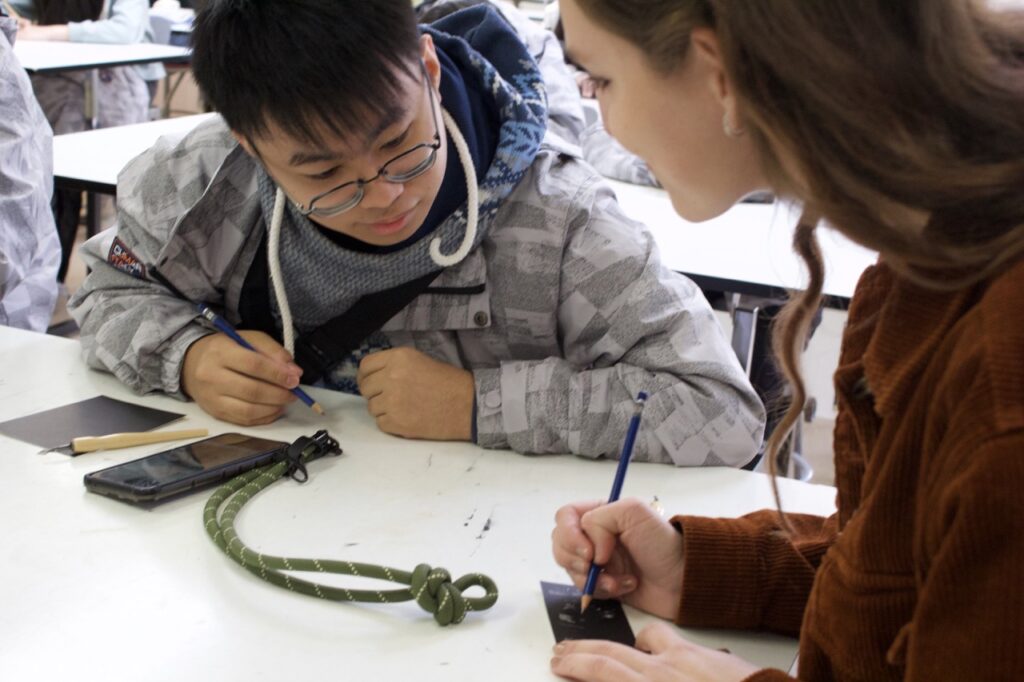
Photo by Andrew Lin
Ceramics teacher Nikki Rodriguez creates a sample artwork for James Wu.
Instead of joining their host students in their seventh-period classes, the guests gathered in the engineering room for a farewell party. Engineering teacher Audrey Warmuth and physics teacher Matthew Welander taught the guests how to build their own mini tensegrity tables to take home. They were also given Golden State Warriors T-shirts.
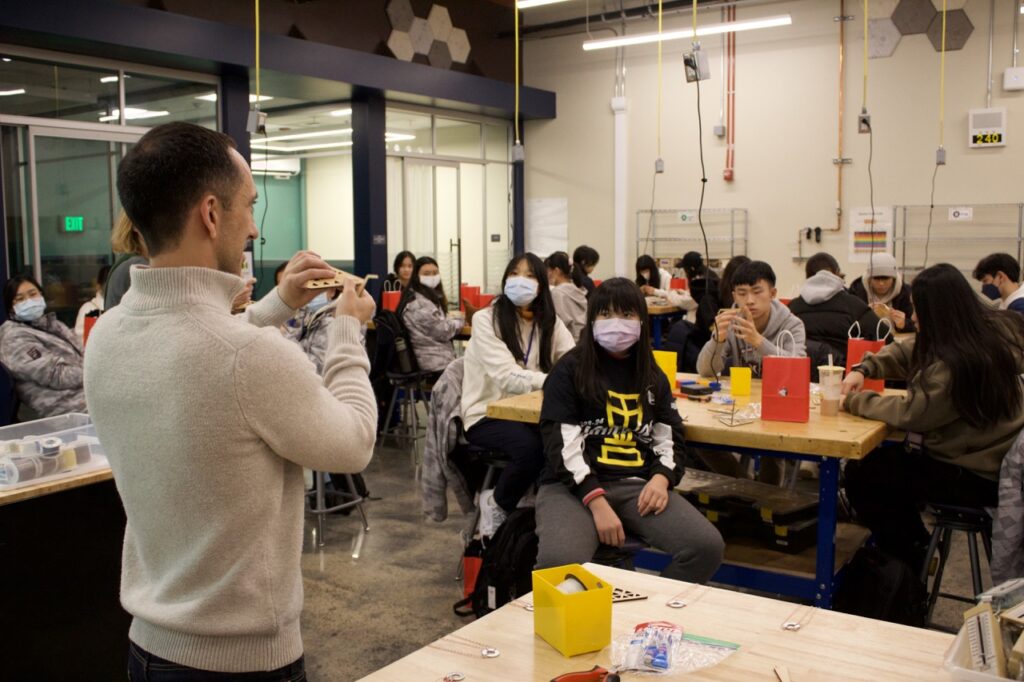
Photo by Andrew Lin
Physics teacher Matthew Welander explains how a tensegrity table works to the guests.
The purpose of the visit for the Taiwanese students was to gain perspective on American culture, education and jobs. They were assigned workbooks to fill out, where they detailed their experiences and insights gained during the trip.
For most of the guests, this trip was their first time setting foot in the United States. Before arriving at SHS, the guests toured the Intel corporate office and the Cupertino City Hall. After leaving SHS, they visited the California Academy of Sciences, Google, Stanford University, UC Berkeley, the Palo Alto fire station and other Bay Area locations.
The 31 visitors were selected out of 100 original candidates in an annual student leadership program called the New Taipei International Youth Technical Leader Group. Selection for the tour of the Bay Area was based on candidates’ behavior in the program, indicated by proactively answering teachers’ questions and participating in activities.
At SHS, the visitors were then thrust into an educational environment very different from what they were used to. Taiwan’s public school system is one of the best in the world, and while U.S. students generally declare a major in their sophomore year of college, Taiwanese students officially decide the direction of their future careers at the start of their second year of senior high school, around age 16. Some students attend trade schools to further specialize in their field before college, paralleling American students’ involvement in specialized extracurricular activities.
The culmination of their secondary education is the national college entrance exam, which they take at the end of their third year. This system of college entrance exams (called gaokao in Mandarin, literally “high exam”) is standard for many Asian countries, like mainland China and South Korea. This is very different from the application process for most American institutions, which place more emphasis on grades and extracurriculars rather than exams like the SAT that are slowly getting phased out.
Although several volunteer host students were fluent Mandarin speakers, and the majority of hosts had a basic (though oftentimes insufficient) grasp of Mandarin, language barriers posed a significant obstacle for some host-guest pairings.
Guests displayed a wide range of English proficiency, from fluent English speakers in the Applied English concentration to students who could hold their own in brief conversations but ended up getting left behind in classes with fast-paced lectures and challenging terminology.
Junior Ryan Heshmati, who does not speak Mandarin, hosted arts and crafts student Yu-Hsing Yu. Like many other host-guest pairs, they made heavy use of Google Translate to communicate.
“Breaking the ice with a language barrier was a slight obstacle but we worked through it and got close (we still message today),” Heshmati said.
“I think the language barrier may have made my experience as a host different from those of Mandarin-speaking students, but it was nonetheless rewarding and I intend on taking part again next year.”
I had the privilege of speaking to three of our visitors on behalf of the Falcon. Below are our conversations.
Yu-Chiao Su: Envisioning exceptional interior environments
Yu-Chiao Su is a third-year interior design student at Fu-Hsin Trade and Art School in New Taipei City. Because she was more comfortable answering questions in Mandarin, both the interview questions and her responses have been translated to English. Connotations may be changed slightly in translation.
Andrew Lin (interviewer): What were your expectations for Saratoga High School before you arrived here?
Yu-Chiao Su: I didn’t really know much about America in general before coming here on this trip because I don’t intend to move to America after college.
Lin: After you’ve spent some time here, what differences have you noticed between American and Taiwanese high schools?
Su: In Taiwan, teachers usually just lecture, sticking to their lesson plans, while in America teachers seem to care more about students’ perspectives and encourage them to share their opinions.
Lin: Are there any significant differences in campus environments?
Su: I think SHS is a bit cleaner, and the overall size of the campus is a lot larger. Our school is very small: Around 40 students are squeezed into one classroom.
Lin: And how big are the classrooms?
Su: Roughly as big as this one. (We were in Room 303, a slightly larger room than average.)
Lin: How is the national college entrance exam going for you?
Su: I can actually get recommended to a college specific to my major, so if the general exam doesn’t go well, I have more options.
Lin: In the United States, we place a lot of emphasis on extracurricular activities. Is Taiwan similar?
Su: No. Although doing things like community service can give you a few points in the eyes of the teachers, it’s absolutely not necessary. The main focus is preparing for the entrance exam.
Lin: Do you have any background in the arts, seeing as you’re in Interior Design?
Su: Yes. (She showed me photos on her phone of her intricately rendered watercolor paintings of pottery; charcoal still lifes; some abstract, geometric compositions and a few professional, 3D-modeled interior concepts.) I don’t like drawing because it’s too restrictive. We have to conform to technique, which I don’t find enjoyable.
Lin: What do you find appealing about interior design?
Su: I think it’s nice to be able to create spaces where people are comfortable.
Kai Wang: Becoming bilingual
Kai Wang is a third-year Applied English student at Nanshan High School. The following conversation occurred in English.
Lin: Before you came here, what did you expect to see?
Kai Wang: I know you guys need to change classes, right? But we won’t, we just stay in a class; we won’t move to other classes. Everyone’s just sitting there, at your own seats, with your own books all at your desk.
Lin: What good qualities have you seen at SHS, and what bad qualities do you think we could improve on?
Wang: You guys are all about freedom. For lunch, you guys can eat outside and you guys can dress how you like, but at our school we have a uniform. We can’t wear what we want. I think that’s a good quality. For bad qualities, I think none?
Lin: Really? I guess you haven’t been here long enough then. Your focus is Applied English. What kind of career options are you considering right now? Do you think you’re going to travel to the U.S. after college?
Wang: I wish to, but I still need to discuss with my parents because it’s far away from my brothers. Some [situations] might be difficult for us, because I’m not very good at English.
Lin: You are good at English.
Wang: No, no, I can talk, but it’s not like you guys.
Lin: Yeah, but you’re good at Chinese too. You’re bilingual.
Wang: But not everyone knows Chinese, right?
Lin: You can pretty much talk to anyone in English and be perfectly fine. So, what made you choose English?
Wang: I learned English when I was a child, like in kindergarten.
Lin: Do you read a lot of English literature, like Shakespeare?
Wang: I didn’t. I started English when I was in kindergarten, so my teachers are all from foreign [countries], but when I went to [high] school, I didn’t have any foreign teachers. So their English is not as fluent as foreign teachers. They won’t teach us [aspects of U.S. culture], they only teach us Chinese stuff. So my English is not improving as fast as usual.
Ting-Yu Li: Artistry in advertising
Ting-Yu Li is a third-year advertising student who also attends Fu-Hsin Trade and Art School. This conversation was translated from Mandarin to English.
Lin: Why did you choose to go into advertising?
Ting-Yu Li: I’m an extroverted person, and I like capturing pictures and being involved in design processes. In Taiwan, a student with an Advertising focus has to do some of everything. At our school, students with similar concentrations tend to take a lot of classes together, so we need to be familiar with software like the Adobe suite and Blender. Do you know what Blender is?
Lin: Yeah, it’s a 3D modeling software.
Li: Right. Also, the seniors design and compile a book commemorating our time here, kind of like your yearbook.
Lin: Do you have experience in the arts?
Li: Yes! (She showed the small group that had gathered around a photo on her phone of a detailed and dynamic painting portraying a woman in lavishly embroidered, traditional dress, rendered in vibrant shades of pink and green. She then showed us a quick marker sketch she made of senior Simarya Ahuja, who she sat next to in a class.) I drew this one in three minutes.
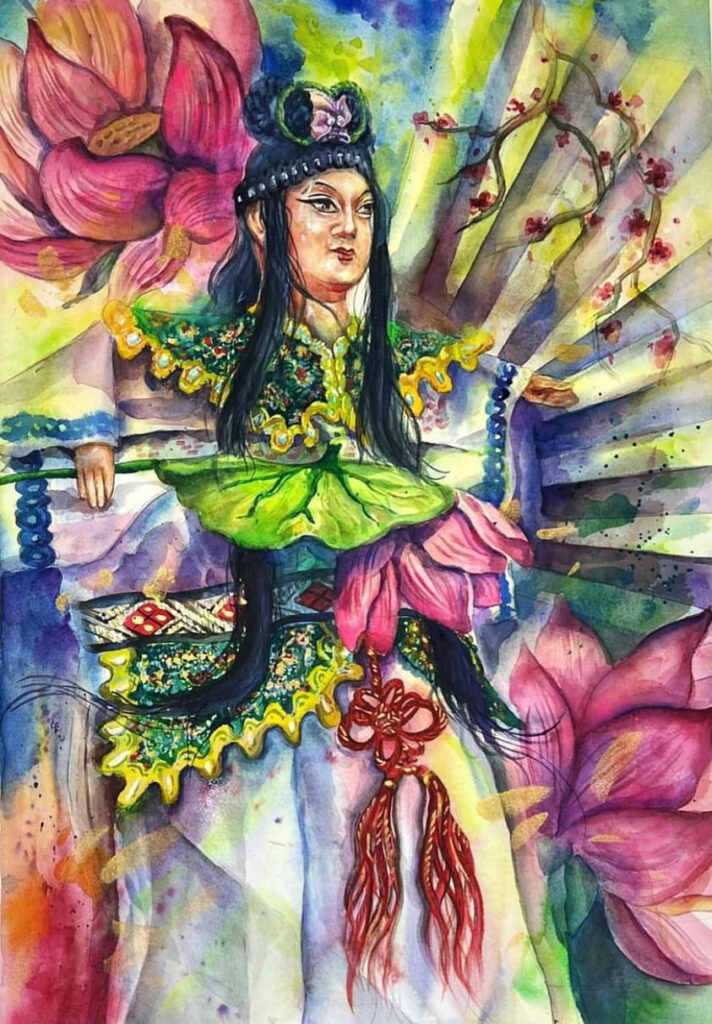
Courtesy of Ting-Yu Li
An artwork Li created for a school assignment.
(I showed one of my own paintings I made for my college application supplemental portfolio to Li. It featured a gloomy composition with a gaunt, distorted man staring defeatedly into a screen, meant to portray the effects of Internet addiction.)
Li: Wow, cool. We’re not allowed to make artwork of this style at our school.
Lin: Is it too scary?
Li: Yes. (My interpretation of this is that as an advertiser, Li aims to make her composition appeal to a broad audience, while art professors in American college admissions boards generally look for more experimental, risky artwork that represents the applicant’s ideas.) What are the dimensions of that painting?
Lin: 18 inches by … honestly I don’t know. My art teacher is from Shanghai.
Li: Shanghai? I went to school in Shanghai in middle school. I actually studied in mainland China for quite a while and only recently started school in Taiwan. That whole time, I’ve been involved in the arts.
Lin: What differences have you noticed between Taiwan and the United States?
Li: You don’t have to wear school uniforms. For us, even on this trip, we have to wear these matching jackets. We can’t take them off either. Also, you’re all allowed to do whatever you want. Over there [in Taiwan], all our classes are chosen for us by the teachers. I heard students at your school can schedule free periods; there’s none of that in Taiwan. Our school day starts at 6:40 a.m. and ends at 9 p.m., so I only get around five hours of sleep every night now.
Lin: What do you plan on doing after college?
Li: I like movies and filmmaking, so I’ll shoot advertisements. Actually, my previous focus was production design. I’m pretty indecisive, so I want to learn about everything.
























